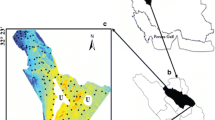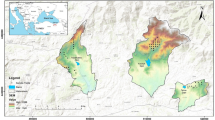Abstract
Soil texture is one of the most important variables in crop production that can influence agriculture plans. Preparing a map showing the different zones of soil texture classes is very important in agricultural planning. The map also serves as a basic map in many soil studies and land suitability. In the present research, the efficiency of different methods of interpolation of soil particle size distribution such as inverse distance weighting (IDW) and geostatistical methods such as kriging, co-kriging, and artificial neural networks (ANNs) was evaluated to predict the soil texture. We collected 105 soil samples from depths of 0–15 cm from Gavoshan dam basin in Kurdistan Province, Iran, and measured their texture by hydrometer method. Next, the map of soil particles groups was prepared using different methods of interpolation in ArcGIS environment. Afterward, the longitude and latitude, height, slope percent, and soil texture particles of training points were introduced to an ANN to estimate soil texture particles by MATLAB software. The accuracy of each method was assessed by statistical indicators such as root mean square error (RMSE), geometric mean error ratios (GMER), and the correlation coefficient (R) with the scoring method. Results showed that the accuracy of the co-kriging was greater than that of kriging in estimating the clay percentage. Although the efficiency and accuracy of ANNs in the estimation of particle size spatial distribution in the sand, silt, and clay was greater than three inverse distance weighting, kriging, and co-kriging methods, the correlation of the model was less than 50% using the ANNs. In this regard, the IDW had a lower accuracy among other methods.













Similar content being viewed by others
References
Aitkenhead MJ, Donnelly D, Sutherland L, Miller DG, Coull MC, Black HIJ (2015) Predicting Scottish topsoil organic matter content from color and environmental factors. Eur J Soil Sci 66(1):112–120
Alizadeh A (2004) Soil physics. Ferdowsi University Press, Mashhad
Amini M, Abbaspour KC, Khademi H, Fathianpour N, Afyuni M, Schulin R (2005) Neural network models to predict cation exchange capacity in arid regions of Iran. Eur J Soil Sci 53:748–757
Ayoubi S, Shahri AP, Karchegani PM, Sahrawat KL (2011) Application of artificial neural network (ANN) to predict soil organic matter using remote sensing data in two ecosystems. In: Atazadeh I (ed) Biomass and remote sensing of biomass, ISBN: 978-953-307-490-0, pp 181-196
Dai F, Zhou Q, Lv Z, Wang X, Liu G (2014) Spatial prediction of soil organic matter content integrating artificialneural network and ordinary kriging in Tibetan Plateau. Ecol Indic, Elsevier Ltd 45:184–194
Davis BM (1987) Uses and abuses of cross-validation in geostatistics. Math Geol 19(241):248
Gee GW, Bauder JW (1986) Particle-size analysis. In: Klute A (ed) Methods of soil analysis. Part 1. Physical and mineralogical methods, 2nd edn. Agronomy no. 9. ASA and SSSA, Madison, pp 383–411
Guo PT, Wu W, Sheng QK, Li MF, Liu H-B, Wang Z-Y (2013) Prediction of soil organic matter usingartificial neural network and topographic indicators in hilly areas. Nutr Cycl Agroecosyst 95:333–344
Heristev RM (1998) The ANN book. GNU Public License, USA
Ingleby HR, Crowe TG (2001) Neural network models for predicting organic matter content in Saskatchewan soils. Can Biosyst Eng 43:71–75
Jiachun S, Haizhen W, Jianming X, Jianjun W, Xingmei L, Haiping ZCY (2007) Spatial distribution of heavy metals in soils: a case study of Changxing, China. Environ Geol 52:1–10
Johnson RM, Downer RG, Bradow JM, Bauer PJ, Sadler EJ (2002) Variability in cotton fiber yield, fiber quality, and soil properties in a southeastern coastal plain. Agron J 94(6):1305–1316
Jorabian M, Zareh T, and Osrovar A (2005) Artificial neural networks, compiled by Shalkov, R. J. Publications of the Shahid Chamran University of Ahvaz. 716 pages
Kisi O (2004) Multi-layer perceptrons with Levenberg–Marquardt optimization algorithm for suspended sediment concentration prediction and estimation. Hydrol Sci J 49(6):1025–1040
Marashi M, Mohammadi Torkashvand A, Ahmadi A, Esfandiari M (2017) Estimation of soil aggregate stability indices using artificial neural network and multiple linear regression models. Spanish J Soil Sci 7(2):89–99
Marashi M, Mohammadi Torkashvand A, Ahmadi A, Esfandiari M (2019) Adaptive neuro-fuzzy inference system: estimation of soil aggregates stability. Acta Ecol Sin 39(1):95–101
Marchetti A, Piccini C, Francaviglia R, Mabit L (2012) Spatial distribution of soil organic matter using geostatistics: a key indicator to assess soil degradation status in central Italy. Pedosphere 22(2):230–242
Meul M, Van Meirvenne M (2003) Kriging soil texture under different types of nonstationarity. Geoderma. 112:217–233
Moghimi S, Mahdian MH, Parvizi Y, Masihabadi MH (2014) Estimating effects of terrain attributes on local soil organic carbon content in a semi-arid pastureland. J Biodivers Environ Sci 5(2):67–106
Mohammadi J (2000) Evaluation and maping of soil salinity hazard in Ramhormoz area (Khuzestan) using disjungtive kriging. J Agric Reas 6:45–57
Mohammadi J (2006) Pedometrics. Pelk press, Tehran In Persian
Mohammadi Torkashvand A, Ahmadi A, Nikravesh N (2017) Prediction of kiwifruit firmness using fruit mineral nutrient concentration by artificial neural network (ANN) and multiple linear regressions (MLR). J Integr Agric 16(7):1634–1644
Parvizi Y, Omid M, Mahdian MH, Amini M (2010) Determination of soil organic carbon variability of rainfed crop land in semi-arid region (neural network approach). Mod Appl Sci 4(7):25–33
Peng-Tao G, Wei W, Qing-Kai S, Mao-Fen L, Hong-Bin L, Zheng-Yin W (2013) Prediction of soil organic matter using artificial neural network and topographic indicators in hilly area. Nutr Cycl Agroecosyst 95:333–344
Somaratne S, Seneviratne G, Coomaraswamy U (2005) Prediction of soil organic carbon across different land-use patterns: a neural network approach. Soil Sci Soc Am J 69:1580–1589
Sun F, Yao Y, Li G (2018a) Comments on: the flow and heat transfer characteristics of compressed air in high-pressure air injection wells. Arab J Geosci 11(20):631
Sun F, Yao Y, Li G, Li X (2018b) Geothermal energy development by circulating CO2 in a U-shaped closed loop geothermal system. Energy Convers Manag 174:971–982
Sun F, Yao Y, Li G, Li X (2018c) Geothermal energy extraction in CO2 rich basin using abandoned horizontal wells. Energy 158:760–773
Sun F, Yao Y, Li G, Li X (2018d) Performance of geothermal energy extraction in a horizontal well by using CO2 as the working fluid. Energy Convers Manag 171:1529–1539
Sun F, Yao Y, Li G, Zhang S, Xu Z, Shi Y, Li X (2019) A slip-flow model for oil transport in organic nano pores. J Pet Sci Eng 172:139–148
Tarr AB, Moore KJ, Bullock DG (2005) Improving map accuracy of soil variables using soil electrical conductivity as a covariate. Precision Agric 6(3):255–270
Xiaopeng Y, Lingqing W (2008) Spatial analysis and hazard assessment of mercury in soil around the coal-fired power plant: a case study from the city of Baoji, China. Environ Geol 53:1381–1388
Zhou T, Shi P J, Luo J Y, Shao Z (2008) Estimation of soil organic carbon based on remote sensing and process model. J Remote Sens 3:139–147
Author information
Authors and Affiliations
Corresponding author
Additional information
Responsible Editor: Biswajeet Pradhan
Rights and permissions
About this article
Cite this article
Khanbabakhani, E., Torkashvand, A.M. & Mahmoodi, M.A. The possibility of preparing soil texture class map by artificial neural networks, inverse distance weighting, and geostatistical methods in Gavoshan dam basin, Kurdistan Province, Iran. Arab J Geosci 13, 237 (2020). https://doi.org/10.1007/s12517-020-5134-1
Received:
Accepted:
Published:
DOI: https://doi.org/10.1007/s12517-020-5134-1




